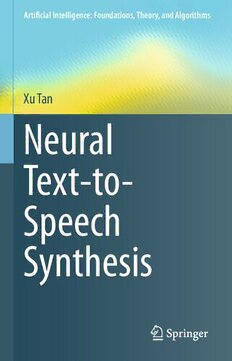
Neural Text-to-Speech Synthesis PDF
214 Pages·2023·9.013 MB·English
Most books are stored in the elastic cloud where traffic is expensive. For this reason, we have a limit on daily download.
Preview Neural Text-to-Speech Synthesis
Description:
Text-to-speech (TTS) synthesis is an Artificial Intelligence (AI) technique that renders a preferably naturally sounding speech given an arbitrary text. It is a key technological component in many important applications, including virtual assistants, AI-generated audiobooks, speech-to-speech translation, AI news reporters, audible driving guidance, and digital humans. In the past decade, we have observed significant progress made in TTS. These new developments are mainly attributed to Deep Learning techniques and are usually referred to as neural TTS. Many neural TTS systems have achieved human quality for the tasks they are designed for.This book first introduces the history of TTS technologies and overviews neural TTS, and provides preliminary knowledge on language and speech processing, neural networks and Deep Learning, and deep generative models. It then introduces neural TTS from the perspective of key components (text analyses, acoustic models, vocoders, and end-to-end models) and advanced topics (expressive and controllable, robust, model-efficient, and data-efficient TTS). It also points some future research directions and collects some resources related to TTS.Although many TTS books have been published, this book is the first of its kind that provides a comprehensive introduction to neural TTS, including but not limited to the key components such as text analysis, acoustic model, and vocoder, the key milestone models such as Tacotron, DeepVoice, FastSpeech, and the more advanced techniques such as expressive and controllable TTS, robust TTS, and efficient TTS. Xu Tan, the author of this book, has contributed significantly to the recent advances in TTS. He has developed several impactful neural TTS systems such as FastSpeech 1/2, DelightfulTTS, and NaturalSpeech, the latter of which has achieved human parity on the TTS benchmark dataset. His knowledge of the domain and his first-hand experience with the topic allow him to organize the contents effectively and make them more accessible to readers, and to describe the key concepts, the basic methods, and the state-of-the-art techniques and their relationships in detail and clearly. I am very glad that he introduced and clarified many key concepts and background knowledge at the beginning of this book so that people with little or no knowledge of TTS can also read and understand the book effectively.This is a very well-written book and certainly one that provides useful and thoughtful information to readers at various levels. I believe this book is a great reference book for all researchers, practitioners, and students who are interested in quickly grasping the history, the state-of-the-art, and the future directions of speech synthesis or are interested in gaining insightful ideas on the development of TTS.
See more
The list of books you might like
Most books are stored in the elastic cloud where traffic is expensive. For this reason, we have a limit on daily download.
